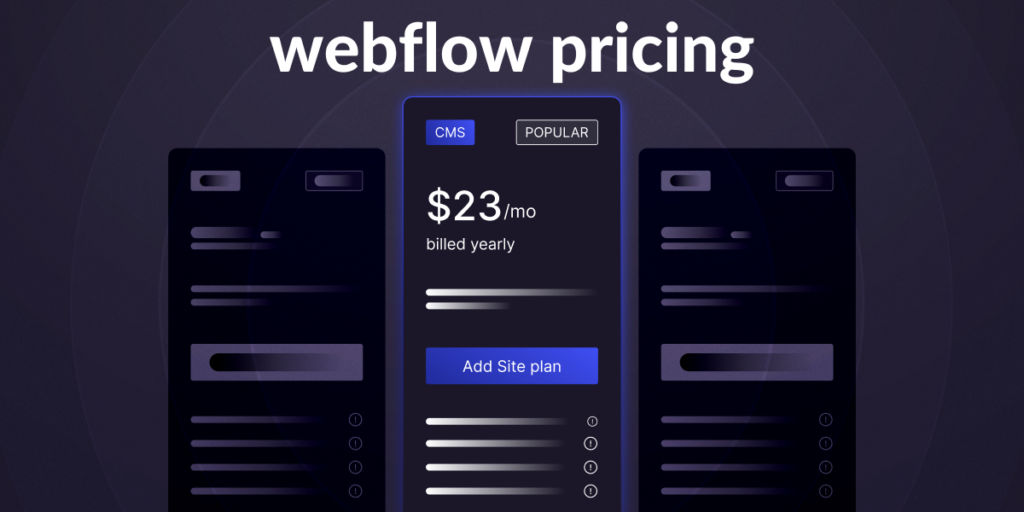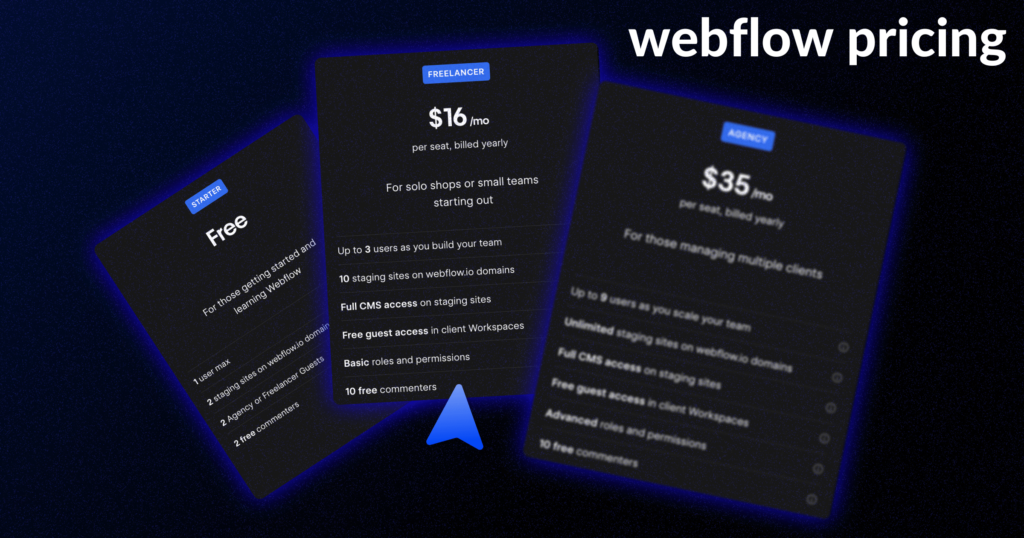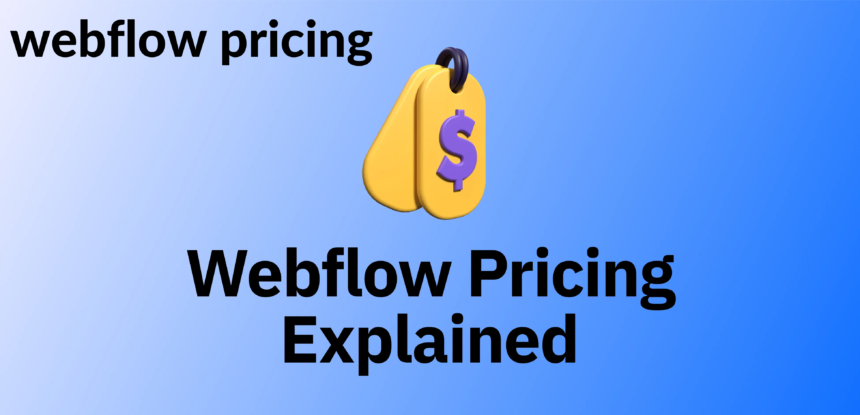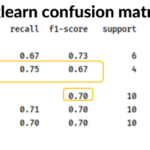Webflow pricing has become one of the most popular website builders, offering a wide range of tools for creating professional websites. But how much does Webflow cost? In this comprehensive guide, we’ll break down Webflow’s pricing in 2025, and the different plans available, and help you choose the right one for your needs.
Understanding Webflow Pricing Plans
Webflow pricing offers several pricing plans to suit different user needs, from personal projects to large businesses. These plans are designed to give users the flexibility to choose what works best for them, whether they are just starting or running a complex e-commerce website. Each plan offers a unique set of features, and understanding them is key to making an informed decision.
Webflow’s pricing structure is divided into two main categories: Website Plans and E-commerce Plans. Website plans are best for personal websites, blogs, and portfolios, while e-commerce plans are designed for online stores that need more advanced functionality. Webflow also provides a Free Plan for beginners, which offers a limited set of features but can be a good starting point for those who want to explore the platform.
Which Webflow Plan is Right for You?
Choosing the right Webflow plan depends on the purpose of your website and the features you need. If you’re just starting out, the free plan might be all you need. However, as your website grows, you’ll likely need to upgrade to a paid plan to access more advanced features like custom domains and enhanced design tools.
Here are some considerations to help you choose:
- Free Plan: Best for experimentation and learning.
- Starter Plan: Ideal for small, personal websites or portfolios.
- CMS Plan: Perfect for blogs and content-driven websites.
- Business and E-commerce Plans: Great for businesses that need high-performance websites and online stores.
Webflow Pricing for Businesses
When it comes to businesses, Webflow offers pricing options designed to scale with your needs. These plans provide access to powerful features such as custom branding, enhanced site performance, and the ability to manage multiple websites. Webflow’s Business Plan is ideal for businesses that require more storage, higher traffic limits, and advanced integrations.

Free Plan Overview
Webflow’s Free Plan is a great option for individuals who are just starting with website design. It offers basic features such as the ability to create a website and publish it with a Webflow subdomain. However, you won’t be able to connect a custom domain, and the website will include Webflow branding.
- Free Plan Features:
- Limited storage
- No custom domain
- Webflow branding
- Suitable for learning and experimenting
Starter Plan: Who Should Use It?
The Starter Plan is perfect for those who want to launch a simple website with minimal investment. This plan allows you to connect a custom domain and remove Webflow’s branding. It’s ideal for freelancers, small businesses, and personal projects that don’t require advanced features.
- Starter Plan Features:
- Custom domain
- No Webflow branding
- Basic site performance
E-commerce Pricing Breakdown
Webflow’s E-commerce Plans are designed for users who want to build and manage online stores. These plans offer advanced features such as product management, order processing, and integrated payment gateways. The pricing for Webflow’s e-commerce plans varies based on the level of features you need.
- Basic E-commerce Plan: Ideal for small businesses that are just starting to sell online.
- Advanced E-commerce Plan: Perfect for large-scale stores that need additional features like advanced shipping options and more products.
Here’s an example of a Bio Table for a person:
| Attribute | Details |
|---|---|
| Full Name | Johnathan Smith |
| Nickname | Johnny |
| Date of Birth | January 1, 1990 |
| Profession | Software Engineer |
| Current Location | San Francisco, CA |
| Nationality | American |
| Education | BSc in Computer Science, Stanford University |
| Skills | JavaScript, Python, Full Stack Development |
| Experience | 5 years as a Senior Software Engineer |
| Social Media | LinkedIn: johnsmith, Twitter: @johnnydev |
| Hobbies | Hiking, Reading, Playing Guitar |
If this isn’t what you’re looking for, could you clarify what kind of bio table you’re interested in? For example, if it’s for a company or a different context, let me know!
Understanding the E-commerce Plan
Webflow’s E-commerce Plan is the perfect choice for anyone looking to create an online store. With features like integrated payments, customizable checkout pages, and product categories, it provides everything you need to build and manage a professional online store.
The pricing varies depending on the size and needs of your store, with different levels offering additional features. For example, the Basic Plan is designed for small stores with fewer products, while the Advanced Plan caters to larger stores that need enhanced capabilities.
Webflow Alternatives to Consider
While Webflow is an excellent choice for website and store building, it’s important to explore alternatives to make sure it’s the right platform for you. Some of the most popular alternatives include:
- Wix: Known for its easy-to-use interface and large selection of templates.
- Squarespace: A website builder with strong design capabilities, ideal for creatives.
- Shopify: The go-to platform for building robust e-commerce websites.
Each of these platforms has its own strengths, and choosing the right one will depend on your specific needs and budget.
Webflow Pricing: Final Thoughts
Webflow’s pricing can seem complex at first, but once you understand the plans available, it’s easier to choose the right one for your needs. The platform is perfect for both beginners and advanced users, and its range of plans offers flexibility as your website grows. Whether you’re building a portfolio, a blog, or an e-commerce store, Webflow provides powerful tools to help you achieve your goals.

Popular Webflow Alternatives
- Wix: A beginner-friendly website builder with drag-and-drop features.
- Squarespace: Known for its visually stunning templates, great for creatives.
- Shopify: Best for e-commerce, offering a wide range of tools to manage online stores.
Basic Webflow Plan
The Basic Webflow Plan is ideal for personal websites or portfolios that don’t require advanced features. It provides access to essential design tools and hosting, along with the ability to use a custom domain. However, it lacks some of the more advanced features needed for larger businesses.
CMS Webflow Plan
The CMS Plan is designed for websites with dynamic content, like blogs or news sites. It allows you to easily manage content and customize the design. This plan is perfect for individuals or businesses that need more control over their website’s content and structure.
Webflow E-commerce Pricing: How Much Does It Cost to Build an Online Store?
The cost of building an online store with Webflow depends on the size of your business and the features you need. The Basic E-commerce Plan starts at $29 per month, which includes essential features for running an online store, such as unlimited products, secure checkout, and integrated payment options. For larger stores, the Advanced Plan offers more customization options and additional features like advanced shipping and tax settings.
The Bottom Line
In conclusion, Webflow’s pricing is flexible, offering a variety of plans to meet the needs of different users, from beginners to large businesses. By carefully considering your needs, you can find the perfect Webflow plan to help you build and maintain a professional website or e-commerce store.








